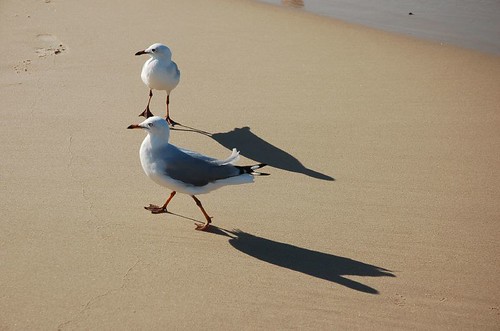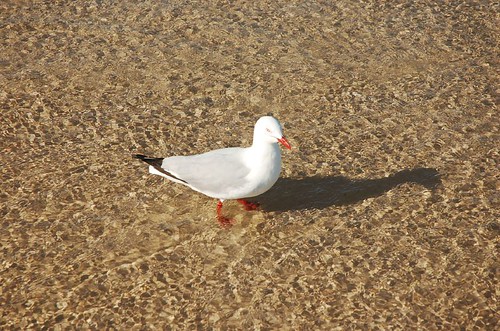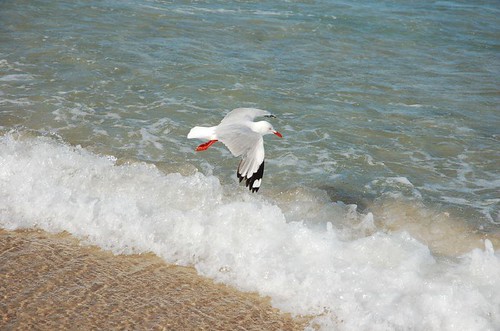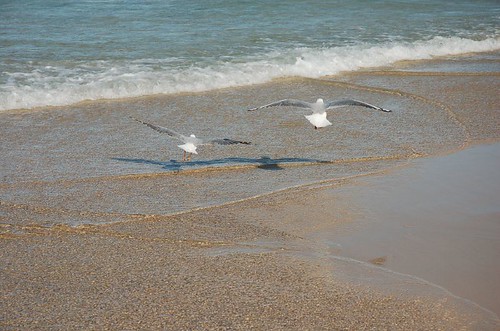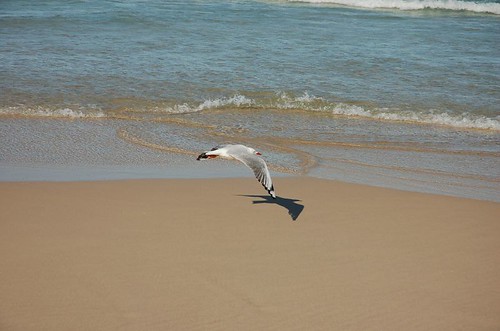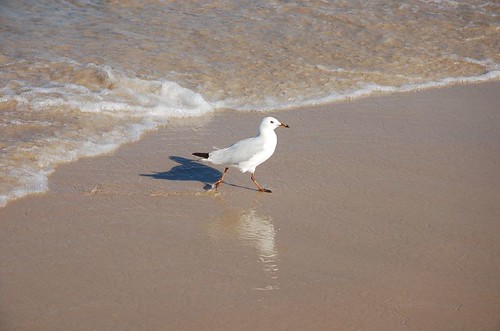In Beijing. I used electronic tickets for this trip.
Yearly Archives: 2006
Happy Birthday to Me
Happy birthday to me. It is my 29th birthday.
Thanks for Henry, Grace, Xiaofeng, Hengge, Robert, Xiaoxiong, Edward and Wendy to be at dinner with me. Wonderful friends, and wonderful gathering.
P.S. I found every birthday, I started the entry with “Happy brithday to me. It is my ??th brithday”, and the number just changed from 25, to 26, 27, 28 and 29…
Blue Check (Check-in) for Virgin Blue
When I talked about the abandon of paper ticket in China, I thought of my experience with Virgin Blue in Australia. Virgin Blue is a low cost airline, and they highly depend on Internet, and automatic processes to do their business.
Here are some pictures I took about the wonderful self-serve check in system.
Below: all you need to know is the six-number confirmation ID: ENTDAC (I guess I have completed the travel and this code is not confidential any more). Enter the code using the onscreen keyboard.
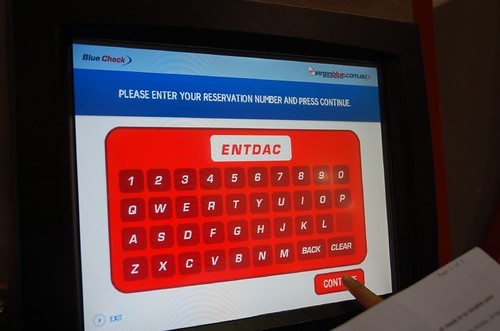
Below: With the code, they know everything about our trip and showed us our names. I selected both.
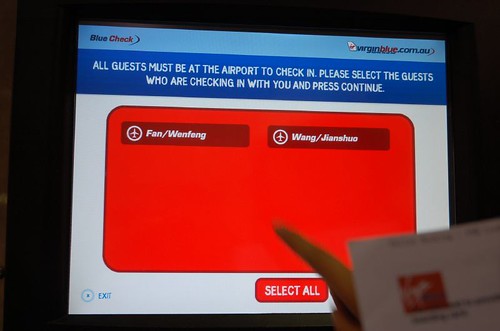
Below: I can also change my seat allocation. One point to notice is, after I choose 6A and 6B for the first trip, the seats remain the same on our other two flights with Virgin Blue.
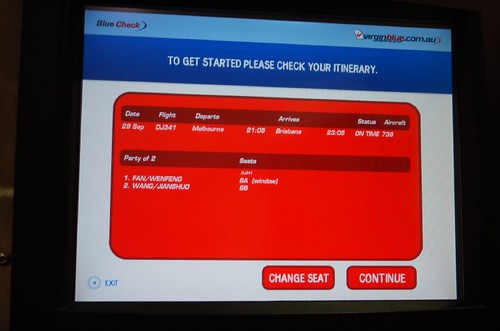
Below: We don’t have luggage, so we choose 0. If I choose other than 0, that is the time I need to see the person in the counter and deposit my luggage.
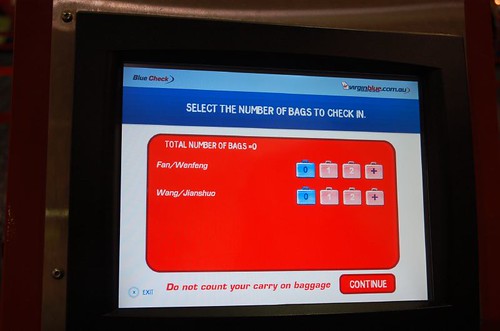
Below: Print boarding pass. Fast, and easy.
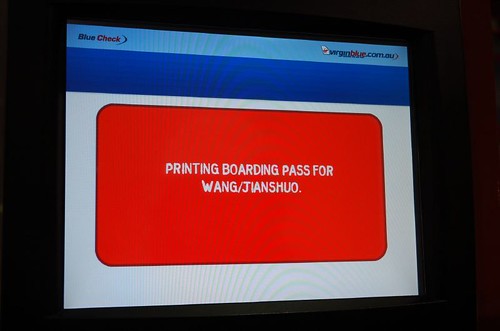
Below: I got my boarding pass (newly printed).
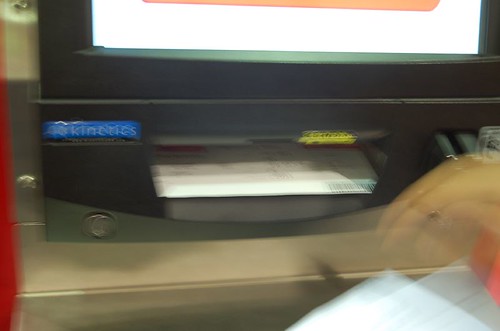
Below: it is done. The boarding gate is 6.
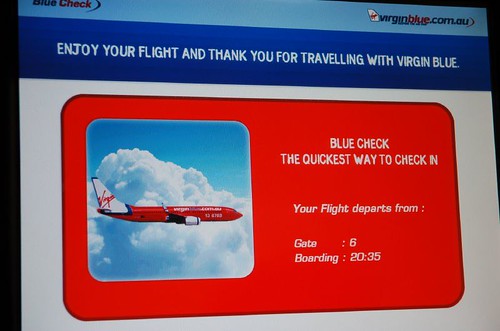
Below. The Virgin Blue flight waiting for getting aboard.
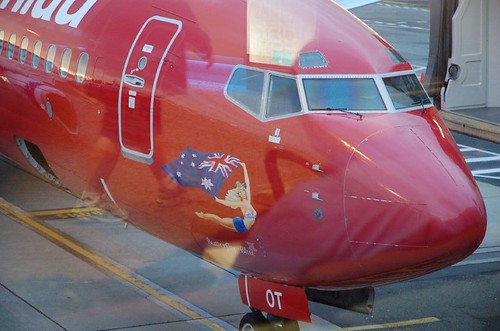
What a wonderful experience (when it worked).
Say Goodbye to Paper Ticket
From yesterday, CATA (China Air Transportation Association) stopped providing paper ticket to ticket agents. This is an event that will eventually affect my life, and many others.
This is a great achievement. When the Southern China Airlines started e-ticket testing in 2000, 6 years past. The user behavior changes slowly, and till now, paper ticket is still 70% of all tickets.
My guess is, from today, travel agents cannot purchase blank paper ticket from CATA. They must have a lot of tickets in stock that they can continue to print out. However, by the end of this year, when most of the paper tickets in stock are used up, the travel agencies have to transit to using electronic tickets.
I am expecting more people using e-tickets and recognize e-ticket.
Reimbursement?
One of the key issue with e-ticket is, it does not work with the current reimbursement practice. In U.S. and other countries, a receipt can be of any form – a piece of paper with handwriting numbers, or printed receipt from a teller machine. In China, however, only government agencies can issue blank invoices, and merchants fill in the blanks on the standard format invoice. Originally paper tickets are type of that “official invoice”.
My friends in U.S. thought the invoice in China is like money note. That is true (with very high-tech anti-fake technology in it).
The e-ticket caused the problem. In many countries, you can just print out the receipt and reimburse with the paper. This is not working.
To meet this need, the travel agents are thinking of ways to workaround it. I believe finally, people still have to go somewhere to get a paper ticket. The blank tickets may still be bought from government, and the travel agents fill in the departing, arriving cities, and the price. This may be even done after the travel. In this case, the paper ticket is not used as part of the travel experience, it is all about the reimbursement (and sometimes tax) experience.
Another example of how the less-developed industry/process (the tax and reimbursement) stops fast pacing industry (airlines) from going faster.
Featured on China Daily
There is a half-page article about this blog on China Daily. Carsten was the first one to notify me this morning, and Ida, the journalist is the second. :-) Thans Ida for the wonderfuo article.
The original article is here.
This is a copy of the artilce. Full credit goes to Ida Relsted, and China Daily.
Shanghai blogger just wants to help
Citizens bloggers website provides millions with useful information about the city he loves to share
Ida Relsted
Shanghai_Delta
page04 2006-10-17
I started my blog to help foreigners survive in the city, because Shanghai is not so easily accessible for people who don’t know it well,” explains 28 year old blogger Wang Jianshuo.
“In 2000 I had a website, both in Chinese and English, and here I wrote an article about Pudong International Airport. When I later searched the Internet for the topic of Pudong International Airport, my article came up as hit number one, which was odd for such an important place. Why had nobody else written about it? When I heard the term “blogger” in 2002, I decided to start a blog to fill the gap, because there seemed to be a lack of information about the city. I truly love Shanghai. Now I have a lot of readers, it is not easy to give up,” Wang says laughing.
His blog does have quite some readership, registering one million hits each month and featuring lively debate between commentators from all over the world. There were an estimated 17.5 million bloggers in China by the end of August 2006, almost 30 times the 2002 figure. Among those, some stand out, like Wang’s blog which not only has many readers, but also offers information on life in Shanghai. The blog has been mentioned in MSNBC, BBC, BusinessWeek, and voted one of the top ten blogs in China in 2003.
The title of the blog is “Events (in Shanghai) that affect my life (and the life of others)”. The blog is a time consuming task as Wang updates it almost daily. “It’s a part of my life, like e-mails and sleep. I also think of it like writing a very big book about my world.”
Commenting on his style, Wang points to the fact that some commentators on the blog have criticized him for only focusing on the positive aspects of life. “My basic philosophy is only to write what I have personally experienced, and to pay attention to details. What distinguishes blogs from traditional media is exactly the way a blog can pay attention to detail. I also always write what I currently believe is true, but my observations may change over time.”
In his job as CEO of Kijiji in China, Wang Jianshuo has had the opportunity to travel and experience different cultures. He is impressed with how different people think, and his ambition is for the blog to be a virtual place for people to be able to debate. On the blog, East meets West, and vice versa.
“As a matter of principle, I don’t delete comments on the blog, because it is a place for sharing views. The beauty of the blog is that when people think so differently from me, it makes me think. It made me write an entry on the topic that common sense is not always common,” says Wang giving the example: Maybe saving money makes sense for the older generation, whereas it makes more sense for the younger generation to have experiences.
“When we are arguing, I ask myself: are we using the same language?” he says about communication gaps.
To the question of how the blog has Changed his life, Wang answers that it has had an impact on his career. When he started blogging in 2002, he worked for Microsoft and was conscious that he was respected because he was a representative of an internationally known company. But he did not want to remain in the shadow of the company, so with the ambition of achieving something for himself, he set out to write the blog. What he wanted to accumulate was writings on small things like advice on transportation – two of the most popular topics are Shanghai taxis and Pudong International Airport – and personal thoughts.
“I also wanted to help, because it seems meaningful. For people who know the blog and arrive here, maybe Shanghai seems not so unfamiliar, and I can give them a feeling of knowing somebody here, before they have arrived,” Wang says.
But also in another, more indirect way, blogging has affected Wang’s life, because, as a result of writing about the minutiae of Shanghai life he has become more sensitive to the things around him. It causes him to think about topics he might never otherwise have considered.
“In order to write a blog you have to have a reason to write. For most bloggers, they don’t have many readers, and I know many frustrated bloggers without visitors on their blogs. Some will even write 40 entries a day trying to attract readers. But you shouldn’t start a blog just to get the attention of readers. You are the most important reader of your own blog, which also means you get to choose the topics of interest.”
One of the humorous downsides of writing the blog is people misunderstanding the concept and e-mailing complaints about lack of specific information or a slow response time from what they expect is an official office. Since this has happened several times, Wang decided to post a small picture of himself on each entry, with the intent of attracting attention to the fact that is merely a free, one-man service.
A much more serious side to the blog came about in 2003, when China experienced the outbreak of SARS. Before this, Wang’s blog did not have that many visitors, but during the outbreak, Jian discovered that many people wanted to hear the point of view of a normal person living in Shanghai. “People in China were very nervous, and we got a lot of attention from media from outside China at that time. I did not start to blog in order to write about politics, on the contrary. Everything was very sensitive, so the only thing I could say was that I could not guarantee I was giving the whole picture, I was only able to tell people a fraction of the story, which was all I could see. So I wrote about how my friends reacted and how restaurants cleaned all the time.”
What really seems to stir Wang’s passion is revealed when he writes details of his life in Shanghai, because in the end, it all comes down to little things: “To report the fact does not always mean to report the truth,” he says.
Beggars in China and People’s Attitude
Ying Zhang commented:
Hi Jian Shuo,
I have been reading your blog for a few years now, I found your blog while planning a trip to China in 2004, and your post on the Shanghai Beijing train time table really helped me. Keep up the good work.
I have always wanted to seek your opinion on an issue that troubles me – about the attitude people have, towards beggars and the homeless in big cities like Shanghai.
If I can’t finish the food in a restaurant, I tend to pack them up and give them to homeless people I met. On rare occasions, if the person is particularly venerable, such as an elderly woman, I will also give out some money. I have done this while I traveled in China, but I have been told by Chinese friends to not do this as ‘all those beggars are faking it’.
One particularly memorable example was when I traveled in the Anhui province. I saw this elderly lady collecting plastic drink bottles, to exchange for a little cash at a recycle point I guess, was teased upon by some youth. She was literally begging the kids (in their teens) to give her the empty bottle they have just finished, but instead of doing the decent thing, they kicked the empty bottle into a lake so she can’t reach it. I had to pull her away from the side of the lake when she tried to get to that bottle to prevent her from falling in. I was furious about this incident for a long time.
In my view she is doing everyone a favor by collecting these bottles and takes them to recycle. It helps keep the environment clean and free from plastic thatmall never be bio-degraded. I have respect for people like these – who are down in their life but still struggles on, doing what little they can (and must) do to survive. Which is the total opposite of a bunch of rich and spoilt kids who probably haven’t worked a single day and only knows how to spend mom and dad’s money. The attitude of people who tease those who are less fortunate than themselves are sickening.
I wonder if you can tell me if this is a common problem / view (that the homeless deserves it) in China. Do you, or have you done anything personally to give them a little help?
All these thoughts came up when I read your comments in today’s post about how Starbucks is the ‘cheapest’ place to enjoy the view of the Bund, and that a cup of coffee cost merely 25RMB (which I’m sure can buy a homeless person a few meals). This reminded me the gap between the well off and the poor are getting increasingly wider in China. I wonder if it will one day become an incurable problem?
Anyway, it’s a long rant, I hope you can give me your thoughts on these issues. Cheers.
Posted by: Ying Zhang on October 16, 2006 08:30 PM
Beggar is Always not an easy topic to discuss. It is a universally controversial topic. Let me try to add more to this heated discussion.
Beggars and People’s Attitude are Mirrors of the Country
Unfortunately, the current society has a lot of problems. Every society has its own problem, but China’s is more obvious. The fast changing pace in economy but slower pace in social insurance system and medical care system makes the life of many people very tough, and without the right supporting system, and common wealth system, it is easy that someone suddenly lose all their income and become a beggar.
The gap between the rich and the poor are bigger day by day, instead of smaller. I don’t want to pretend to know China well, since every time when I put my own steps into the vast west land of China, or even my home town, and see it using my own eyes (not from media inside or outside China), I realize how little I know about my own country. The reality is just worse than I thought. For a big country like China, we are always a learner to know more about it, and cannot claim to know it all.
In the last few years, at least, I witnessed my home town became poorer and poorer. The old houses look so nice with decent decoration, which is never seen in new (can I call it new?) houses. In cities, many workers lost their jobs, but have a family to support, they really don’t have too much choices to make a living. I believe a big portion of them are very risky to be a beggar.
There must be more beggars than before (the true beggars), and we should try everything to help them.
People’s Attitude
It is said: “The Media is the king without a crown”. It is so at least when the media attackes the weak – the beggars. I don’t know when it started, the “fake beggar” became a hot topic. In media reports, some beggars were caught blood-handed to be fake beggar. They either have luxurious life after “working hours”, or pretend to be disabled, or pretend to be stolen.
This kind of report appeared on newspaper and TV, and successfully bulit an evil image for the beggars as a group.
That must be one of the important reasons that people are more and more hesitate to offer some help. For them, beggars equal to fake beggars. I myself also held the opinion in 2003 when I wrote my first article on beggar (my current view changed a lot).
Among all the cheating beggars, there are even a group called “Child beggars”. Their stories are really heart-breaking. I believe many people experienced being approached by little child (5 – 8 years old), and embrace your legs so you cannot move, and beg for money. Chances are, the little poor children are just a tool for their boss to make money. They were beaten to work, and if they don’t get enough money back, they don’t have meal. How hard a decision whether to give money to them or not. On one hand, to give the money enables their “boss” to gain money and finance them to caught, or steal more children to do their business, on the other hand, if you don’t help the little children by giving them one or two RMB, they face starving that night.
OK. Enough about fake beggars. There are many of them. HOWEVER, my point is, fake beggars are not the whole story. There are so many people who need help and cannot find any help beside people on the street. The number of the later must be bigger than the fake beggars.No data to support. I just guessed.
How to Treat the Beggars?
In this diversified world, everyone has their own rules. This is my rule.
There must be someone who take beggar as a profession. They are mainly disabled people who cannot make a living. Their life line is maintained by small money people gave them. Typically, I unconditionally support them.
For many other beggars that you have no idea about whether they are truly in need of help or just pretend to be a beggar and take your money, currently I just gave coins without judgement. This seems stupid. I know many times I was cheated, but just according to the story of the movie Eight Below, it is not about the beggars, it is about you.
Some people have strong rules, like this is very funny:
If they ask for money,
I gave them food;
If they ask for food,
I gave them money
Everyone has their own rules. For the matter of treating beggars, there is no universally correct answer. How someone behave is just how they treat their own lives, instead of the beggars’ lives.
How to Help Them?
Everyone wants to help. The question is, how to help? Giving some coins help (which I usually do), however, is there better ways to help?
I once wrote an entry in February 2005, named Life in a Low Cost Labor World. That is maybe the most criticised article on this blog. I wrote another article to clarify: Helping by Hiring. The point I’d like to make in the second article is,
Simply giving money does not help Ayi who need a job, only by hiring them, and encourage more people to hire them makes lasting and positive impact.
The rule also applies for beggars. There must be better way to help them.
Lend Money to Beggars? Sounds Crazy?
It is announced that these days, the Nobel Peace Prize went to Muhammad Yunus, who did microfinance for the poor, and those who need help. I studied his microfinance bank thoroughly, and found how amazing Muhammad’s idea is.
Muhammad never gave a penny to beggar. This is from a report:
So he never responds when a blind or crippled beggar or a mother cradling her baby holds out a hand for money. “I feel bad – sometimes I feel terrible – that I’m denying the person. But I restrain myself. I never give them anything” Yunus told Reuters in a recent interview at Grameen head office. “I would rather try to solve the problem than just give them a hand and take care of them for the day.”
He thought of the idea to lend (please note: not to give, but just lend) a mobile phone to the beggar, such enable the beggar to ask “Do you need to use a mobile phone?” before he/she ask for money. People can use the mobile phone and pay minimum money. This way, he helped many beggar to stand on their own, make a living and even get to a much better life.
This is the way I really admire and think about.
Coverage of Beggar, and other Dark Side of the City, on this Blog
I talked about beggar in this entry: Crime and Beggars in Shanghai, in which I claimed the even tough problem in Shanghai are the false beggars, or fake beggars who pretend to be beggars.
I was strongly against “No beggars permitted in Metro station” in 2005, but changed my mind one year later.
Again, beggar is not an easy topic to discuss.
In this blog, as everyone may notice (and some complained) that it focuses on Shanghai, especially some good part of it (the beautiful scene of the Bund is one example). This is true, and it is just my life. I don’t shy away to write about it, because one of the three principle for this blog is, “Be Truthful”, which means I don’t write down anything I know is not truth. (If you are interested, the other two principles are: Be Personal, and Show Details.) The light part is just as true as the dark side of a city.
Must See – Coffee Facing the Bund
If you are a visitor to Shanghai and there is nothing to do for one night, I suggest you to spend the night in a bar or restaurant on the riverside, along the Huangpu River. It is opposite to the Bund.
Location
The Bund is symbolic scene for Shanghai. Most visitors view the Bund on the Bund side. To see the Bund from the other side is as excite, if more, than to see it in Puxi.
The area is called Fucheng Road Riverside (浦东滨江富城路段). From the Bund, you can clearly identify the area by looking for Starbucks logo. There are also two McDonald’s ice cream shops there.
Walking Route
This walking route include a ferry ride, when you can view both side of the river on the ferry, and a short walk to see all the bars and restaurants, so you can choose your favorite bar and sit down.
1. Start from the Ferry Station at the East Jinling Road (金陵东路). Take the ferry (2 RMB for the air-conditioned one) to the other side. It takes about 10 minutes (1 km long)
2. Walking out of the Ferry station in Pudong, and turn left to the Fucheng Road (富城路), heading north for a short walk. On immediate right hand are the Tomson Riviera (汤臣一品), a residential building clusters famous for both great view (as you can see it when you walk by), and high price (13,750 USD per sq. meter). The smallest apartment in the building costs 6 million USD, and many is more than 10 million USD.
3. Then after the CitiGroup building, you arrive at the Shangri-La hotel. On the left, there is a small gate with “Red Dot” advertisement. That is the place you should enter the riverside.
Choices of Bars
My favorite are Starbucks and Haagen-Daze. The key reason is, they are maybe the cheapest place and have the best view.
A cup of coffee in Starbucks is the same as others in the city, even similar with stores around the world – 22 – 26 RMB. If it is too crowded for the Starbucks (a seat is not easy after 8:00 PM), you may try Haagen-Daze. Spend 25 RMB to get a cup of “English Breakfast” (it is the name of the tea), and you can stay with the nice beautiful scene for hours.
If you want to have dinner, I highly recommend Paulaner. The beer is German genuine (according to Wendy who enjoyed German beer very much), and they have plenty of seats outside along the river.
Others to Consider
All the lights were turned off at 10:30 PM sharp. Schedule your stay according to the lights. Without lights, the Bund seems mysterious, and is no longer splendid, magnificent, wonderful, breathtaking… (the words people use to describe it).
2006 Asian Gaelic Games in Shanghai
Autumn arrives in Shanghai. When Wendy and I passed the garden before my apartment in Pudong, yellow leafs were falling to grassland with wind. There is an old Chinese saying: You see autumn just from a leaf
. It is very true.
It is the nice weather for us to go to Biyun International District. I love that area very much, especially on sunny weekend. That is an international district, and there are many good restaurants, coffee shop, and nice greenlands. I bought a copy of Lonelyplanet Travel Writing from the foreign language store there.
Strange Football
At the football field, many teams are playing an interesting game. It is something between football and volleyball. The playground is a football ground, the ball is a football, but the players just use hands to take the ball and run, and sometimes use foot to kick the ball to pass it to other player. The other player get the ball with hands, run with it, and use foot sometimes. The wear just like football players.

Image credit: Shanghaistreets. Note: I didn’t take this photo. Also, it is the photo of 2005, not this year.
On the other field, I saw the logo: 2006 Asia Gaelic Games. I have no idea about what Gaelic, until I did some research back home.
Gaelic football (Irish: peil ghaelach), commonly referred to as “football”, “Gaelic” or “gah”, is a form of football played mainly in Ireland. Teams of 15 players kick or punch a round ball toward goals at either end of a grass pitch. Gaelic football is one of four Gaelic sports run by the Gaelic Athletic Association also called the ‘GAA’.
While not widely known, those who do know it recognise this sport as a strong, skillful, fast paced game. As one commentator put it, “It’s like ballet, but more poetic”.
Source: Wikipedia
Many Countries Participated
On site, I saw country flag of Korea. How interesting that a not-so-widely-known game like Gaelic has an Asia competition in Shanghai. Weired.
Many local people stood near the game field and watched this “strange” game.
More Gaelic Football photos in Shanghai by Shanghaistreets.
It Continues Tomorrow
What to see this “rare” game? It is still there tomorrow.

Image credit: asiagaelicgames
Location: Dulwich International School (just near the Carrefour in Jinqiao.
Transportation: Taxi (the nearest metro station is Shanghai Science and Technology Museum, or bus 777
My Personality Test
I received an interesting test on personality, and here is my answer to some of the questions. It seems I am not an organized person.
When you go somewhere for the day, would you rather
[ ] plan what you will do and when, or
[X] just go?
If you were a teacher, would you rather teach
[ ] fact courses, or
[X] courses involving theory?
Do you prefer to
[ ] arrange dates, parties, etc., well in advance, or
[X] be free to do whatever looks like fun when the time comes?
Do you prefer to do many things
[X] on the spur of the moment, or
[ ] according to your plans?
Does following a schedule
[ ] appeal to you, or
[X] cramp you?
Does the idea of making a list of what you should get done over a weekend
[ ] appeal to you, or
[X] leave you cold?
In doing something that many other people do, does it appeal to you more to
[ ] do it in the accepted way, or
[X] invent a way of your own?
The Bund Sightseeing Tunnel
There is a tunnel connecting the two banks of the Huang Pu River – the Bund Sightseeing Tunnel. It is a great way to get across the Huangpu River if you are on any side of the river and want to go to the other. BTW, beside this, you may take ferry or take the metro to get cross – to take a taxi is not so wise since the taxi has to get back toward west from the Bund, enter the tunnel to the east, and get back to west after going out of the Yan’An Road Tunnel…
Back to the Bund Sightseeing Tunnel. The price is 30 RMB single trip and 40 RMB round trip. It basically is a tunnel with rails in it and small carts like those on the cable cart in mountains run on the rail. The tunnel is not well decorated – or to better put it, it is decorated using the technology 30 years go – just some colorful lights shining on the wall of the tunnel. It is kind of funny to see this if you have high expectation about what a “Sightseeing” tunnel will be. Of cause there is no transparent glasses which you can see the water of the river.
Have a try for the tunnel as a tourist. No local in Shanghai really take it as a way to go across the river.
In comparision to the single trip price 30 RMB, the most expensive ferry costs 2 RMB and metro (Lujiazui Station to Middle Henan Road Station) cost 2 RMB also. Taxi costs like 20 RMB. A point to make here – it is only 646.7 meters for the tunnel, but for a taxi to get to the same location, it may takes up to 5000 meters.
Z Series Train in China
Z-Series of trains are fastest and among the best trains in China. Z means “Zhida” in Chinese, or “Direct Express”. Typically they don’t stop in the middle, and is very effecient to travel for long distance, like from Shanghai to Beijing, without stopping in the middle.
These are all Z Trains in China (data is updated on July 2006)
| Train # | Seq | Station Name | Arrive | Depart | Distance |
| Z1 | 1 | Beijing | – | 1935 | 0 |
| Z1 | 2 | Wuxi | 0638 | 0649 | 1337 |
| Z1 | 3 | Shanghai | 0747 | – | 1463 |
| Z10 | 1 | Hangzhou | – | 1803 | 0 |
| Z10 | 2 | Beijing | 0733 | – | 1664 |
| Z11 | 1 | Beijing West | – | 2049 | 0 |
| Z11 | 2 | Wuchang | 0714 | – | 1225 |
| Z12 | 1 | Wuchang | – | 2049 | 0 |
| Z12 | 2 | Beijing West | 0714 | – | 1225 |
| Z13 | 1 | Beijing | – | 1907 | 0 |
| Z13 | 2 | Shanghai | 0705 | – | 1463 |
| Z14 | 1 | Shanghai | – | 1900 | 0 |
| Z14 | 2 | Beijing | 0658 | – | 1463 |
| Z15 | 1 | Beijing | – | 2030 | 0 |
| Z15 | 2 | Harbin | 0710 | – | 1248 |
| Z16 | 1 | Harbin | – | 2032 | 0 |
| Z16 | 2 | Beijing | 0707 | – | 1248 |
| Z17 | 1 | Beijing West | – | 1800 | 0 |
| Z17 | 2 | Changsha | 0740 | – | 1587 |
| Z18 | 1 | Changsha | – | 1748 | 0 |
| Z18 | 2 | Beijing West | 0728 | – | 1587 |
| Z19 | 1 | Beijing West | – | 2028 | 0 |
| Z19 | 2 | Xian | 0758 | – | 1200 |
| Z2 | 1 | Shanghai | – | 1847 | 0 |
| Z2 | 2 | Wuxi | 1946 | 1949 | 126 |
| Z2 | 3 | Beijing | 0651 | – | 1463 |
| Z20 | 1 | Xian | – | 1923 | 0 |
| Z20 | 2 | Beijing West | 0653 | – | 1200 |
| Z21 | 1 | Beijing | – | 1900 | 0 |
| Z21 | 2 | Shanghai | 0658 | – | 1463 |
| Z22 | 1 | Shanghai | – | 1907 | 0 |
| Z22 | 2 | Beijing | 0705 | – | 1463 |
| Z29 | 1 | Beijing | – | 2137 | 0 |
| Z29 | 2 | Yangzhou | 0804 | – | 1227 |
| Z3 | 1 | Beijing West | – | 2042 | 0 |
| Z3 | 2 | Hankou | 0652 | – | 1205 |
| Z30 | 1 | Yangzhou | – | 2010 | 0 |
| Z30 | 2 | Beijing | 0620 | – | 1227 |
| Z37 | 1 | Beijing West | – | 2035 | 0 |
| Z37 | 2 | Wuchang | 0700 | – | 1225 |
| Z38 | 1 | Wuchang | – | 2035 | 0 |
| Z38 | 2 | Beijing West | 0700 | – | 1225 |
| Z4 | 1 | Hankou | – | 2111 | 0 |
| Z4 | 2 | Beijing West | 0721 | – | 1205 |
| Z41 | 1 | Tianjin | – | 2040 | 0 |
| Z41 | 2 | Shanghai | 0740 | – | 1326 |
| Z42 | 1 | Shanghai | – | 1942 | 0 |
| Z42 | 2 | Tianjin | 0641 | – | 1326 |
| Z49 | 1 | Beijing | – | 2144 | 0 |
| Z49 | 2 | Nanjing | 0722 | – | 1160 |
| Z5 | 1 | Beijing | – | 1914 | 0 |
| Z5 | 2 | Shanghai | 0712 | – | 1463 |
| Z50 | 1 | Nanjing | – | 2106 | 0 |
| Z50 | 2 | Beijing | 0644 | – | 1160 |
| Z6 | 1 | Shanghai | – | 1914 | 0 |
| Z6 | 2 | Beijing | 0712 | – | 1463 |
| Z61 | 1 | Beijing | – | 2240 | 0 |
| Z61 | 2 | Changchun | 0702 | – | 1006 |
| Z62 | 1 | Changchun | – | 2235 | 0 |
| Z62 | 2 | Beijing | 0700 | – | 1006 |
| Z7 | 1 | Beijing | – | 1921 | 0 |
| Z7 | 2 | Shanghai | 0719 | – | 1463 |
| Z73 | 1 | Beijing | – | 2130 | 0 |
| Z73 | 2 | Hefei | 0725 | – | 1110 |
| Z74 | 1 | Hefei | – | 2035 | 0 |
| Z74 | 2 | Beijing | 0630 | – | 1110 |
| Z77 | 1 | Beijing West | – | 2056 | 0 |
| Z77 | 2 | Luohe | 0342 | 0344 | 829 |
| Z77 | 3 | Xingyang | 0501 | 0503 | 991 |
| Z77 | 4 | Xiaogan | 0640 | 0642 | 1135 |
| Z77 | 5 | Hankou | 0721 | – | 1205 |
| Z78 | 1 | Hankou | – | 2029 | 0 |
| Z78 | 2 | Xiaogan | 2110 | 2112 | 70 |
| Z78 | 3 | Xingyang | 2251 | 2253 | 214 |
| Z78 | 4 | Luohe | 0010 | 0020 | 376 |
| Z78 | 5 | Beijing West | 0707 | – | 1205 |
| Z8 | 1 | Shanghai | – | 1928 | 0 |
| Z8 | 2 | Beijing | 0726 | – | 1463 |
| Z85 | 1 | Beijing | – | 1928 | 0 |
| Z85 | 2 | Suzhou | 0648 | – | 1379 |
| Z86 | 1 | Suzhou | – | 2000 | 0 |
| Z86 | 2 | Beijing | 0719 | – | 1379 |
| Z9 | 1 | Beijing | – | 1853 | 0 |
| Z9 | 2 | Hangzhou | 0823 | – | 1664 |
It may be a little bit hard to read, since if a train passes two stations, there will be two rows in this table, and the return train has a different number as the other way train.
Look at this page to check out some pictures of one of the Z-train:
To answer Amanda’s question at October 11, 2006 11:17 PM:
First, Jian Shuo Wang, this is a great source of information! Thank you for keeping this up!!!
My family and I (4 people) are hoping to travel from Suzhou or Shanghai to Beijing on 10/26 and return to Suzhou or Shanghai on 10/30.
My main questions are:
1. We want to get on the Z trains (cleaner, newer, more comfort–we will have our 3 1/2 yr. old son) what is the best Z train to book for Suzhou/Shanghai to Beijing and Beijing back to Suzhou/Shangai?
2. We need a 4 bunk room, do the 4 bunks have doors that lock?
3. Do all 4 bunk cars share a communal bathroom? Or do the 4 bunks have private baths?
4. Another person on another forum suggested bringing bed bug spray…honestly that suggestion freaked me out!! Are the trains clean….are bed bugs something we should be concerned about?
5. Is it best to buy tickets in China or online through a website?
Also, if you have other suggestions please feel free to share!
Thank you!
Amanda
Here are my answers:
goes from Suzhou to Beijing (the only Z train in Suzhou) and there are many Z train from Shanghai to Beijng. It is easy.
There are 4 beds in a cub, and they have door, so leave it private room perfectly for a family. But check with the people selling the ticket to you, and make sure you are in the same room.
They have public bath room – shared by the same train cart, but it is as clean as hotel – at least by my standard.
Personally, I don’t think a sleeping bag is neccessary for a Z train. It MAY be needed for other very old style train, but not on Z train. Check out the picture thought to see if your standards need a bag.
You can buy the ticket either online or in China. Online price typically are more expensive (since they typically are travel agents and there is no website for the train company), and if you can get a ticket, the ticket price is the same everywhere in China. There is no discount, no different whether you buy it one month in advance or just buy it the same day.
Have a good trip.
Top Commenters for Sept, 2006
Thanks to the top commenters in September 2006:
carsten 15
Stephen 12
Shaun 12
Thanks for your comments, which is always an important part of this blog.
Hotel! Hotel! Hotel!
To travel in a different country is different than traveling in the same country, especially different from travelling to very familiar cities. This trip made me understand what is the most important stuff for people just arrived to a new city – “How can I get to my hotel, as fast as I can?”
I started to understand why many travellers asked me the question: “I will go to Shanghai on xxxx, and I will stay in xxxxxx hotel. Would you please tell me how I can get to xxxxxxx hotel from Pudong Airport?”
In an airport full of charaters you don’t understand, with people that you are not so easy to communicate, and with the jetlag, hungry/thirsty/tired, maybe the only thing that people care is, where is my hotel? My reserved hote!
Hotel is so sweet. For example, when we set our foots onto the land of Sydney, without checking anything else, we rushed to the IBIS hotel, and even slept for two hours.
So a guide to tell people how to get from Pudong Airport to their hotel must be very useful. Nothing more, nothing less, just a page with direction to get to THE hotel.
Airport ======> Hotel!
P.S. ibis is a very nice hotel. We stayed in
- Hotel Ibis World Square, Sydney
- Hotel Ibis Sydney Airport, Sydney
- Hotel Ibis Melbourne
- Hotel Ibis Brisbane
Train from Shanghai to Nanjing
Many people asked me for suggestion to visit other places by train. It is a FAQ, and I finally found out the train schedule (in English). Please check out this sample. You will see how frequent the train from Shanghai to Nanjing is. If you check out this table, there are 53 trains leave Shanghai and go to Nanjing every single day! That is one train every half an hour. Click the train no to find out more about the specific train.
| Train # | Shanghai -> | Suzhou -> | Wuxi -> | Changzhou -> | Zhenjiang -> | Nanjing | Duration | Distance (km) |
| 5152/5153 | >0025 | 0132 | 0204 | 0256 | 0346 | 0431 | 4:31 | 303 |
| 5054 | >0415 | 0518 | 0548 | 0622 | 0719 | 0812 | 4:12 | 303 |
| 5046/5047 | >0422 | 0525 | 0555 | 0641 | 0743 | 0827 | 4:27 | 303 |
| 5056 | 0520 | 0624 | 0704 | 0749 | 0854 | 0942 | 4:42 | 303 |
| 5026/5027 | >0553 | 0656 | 0731 | 0825 | 0941 | 1027 | 5:27 | 303 |
| 2526/2527 | >0650 | 0800 | 0830 | 0901 | 0957 | 1105 | 5:05 | 303 |
| T732/T733 | >0658 | 0751 | 0818 | 0847 | 1005 | 4:05 | 303 | |
| K376/K377 | >0816 | 0944 | 1014 | 1046 | 1150 | 1232 | 4:32 | 303 |
| T704 | >0830 | 0929 | 1047< | 2:47 | 303 | |||
| T706 | >0837 | 0919 | 1054< | 2:54 | 303 | |||
| T708 | >0844 | 1016 | 1134< | 3:34 | 303 | |||
| K290/K291 | >0851 | 1009 | 1039 | 1113 | 1204 | 1301 | 5:01 | 303 |
| K56/K57 | >0907 | 1002 | 1032 | 1106 | 1157 | 1239 | 3:39 | 303 |
| 1346/1347 | >0914 | 1016 | 1046 | 1120 | 1224 | 1308 | 4:08 | 303 |
| L78/L79 | >0925 | 1052 | 1242 | 1317 | 1415 | 1502 | 6:02 | 303 |
| T712 | >0935 | 1026 | 1054 | 1127 | 1213 | 1254 | 3:54 | 303 |
| K234/K235 | >1142 | 1245 | 1317 | 1350 | 1443 | 1525 | 4:25 | 303 |
| K294/K295 | >1225 | 1341 | 1416 | 1449 | 1539 | 1623 | 4:23 | 303 |
| K34 | >1300 | 1401 | 1431 | 1504 | 1555 | 1639 | 3:39 | 303 |
| 2182/2183 | >1314 | 1416 | 1446 | 1524 | 1630 | 1743 | 4:43 | 303 |
| 1352/1353 | >1347 | 1510 | 1540 | 1613 | 1713 | 1756 | 4:56 | 303 |
| T740 | 1410 | 1501 | 1528 | 1600 | 1644 | 1729 | 3:29 | 303 |
| 1462 | >1425 | 1528 | 1617 | 1651 | 1746 | 1903 | 5:03 | 303 |
| T736/T737 | >1450 | 1541 | 1608 | 1640 | 1723 | 1802 | 4:02 | 303 |
| N516 | >1457 | 1558 | 1628 | 1659 | 1838 | 1921 | 5:21 | 303 |
| T132/T133 | >1523 | 1614 | 1641 | 1710 | 1754 | 1833 | 3:33 | 303 |
| T726/T727 | >1544 | 1634 | 1700 | 1840 | 3:40 | 303 | ||
| K461/K464 | >1551 | 1726 | 1820 | 1851 | 1941 | 2025 | 5:25 | 303 |
| T718 | >1604 | 1714 | 1853< | 2:53 | 303 | |||
| T760 | >1618 | 1710 | 1752 | 1830 | 1946< | 3:46 | 303 | |
| T138/T139 | >1625 | 1717 | 1744 | 1813 | 1929 | 3:29 | 303 | |
| 1658/1659 | >1632 | 1745 | 1843 | 1918 | 2033 | 2226 | 6:26 | 303 |
| T116/T117 | >1643 | 1734 | 1801 | 1939 | 3:39 | 303 | ||
| K152/K153 | >1652 | 1801 | 1832 | 1909 | 2000 | 2045 | 4:45 | 303 |
| T730 | 1701 | 1752 | 1955 | 2:55 | 303 | |||
| T722 | >1733 | 1830 | 1857 | 1927 | 2011 | 2052 | 3:52 | 303 |
| K188/K189 | >2017 | 2113 | 2144 | 2216 | 2341 | 0028 | 4:28 | 303 |
| K372/K373 | >2026 | 2137 | 2208 | 2255 | 2348 | 0044 | 4:44 | 303 |
| T52/T53 | >2038 | 2129 | 2156 | 2225 | 2341 | 3:41 | 303 | |
| T178 | 2052 | 2148 | 2216 | 2246 | 0003 | 4:03 | 303 | |
| 2582/2583 | 2059 | 2159 | 2230 | 2303 | 0005 | 0051 | 4:51 | 303 |
| K282/K283 | >2106 | 2206 | 2237 | 2310 | 0015 | 0058 | 3:58 | 303 |
| 5018/5019 | >2113 | 2214 | 2245 | 2328 | 0023 | 0106 | 4:06 | 303 |
| L114 | >2122 | 2247 | 2350 | 0054 | 0210 | 0257 | 5:57 | 303 |
| N512/N513 | 2144 | 2256 | 2328 | 0002 | 0057 | 0202 | 5:02 | 303 |
| N518/N519 | >2202 | 2311 | 2342 | 0017 | 0113 | 0155 | 3:55 | 303 |
| K360/K361 | >2209 | 2303 | 2335 | 0010 | 0104 | 0146 | 3:46 | |
| N538/N539 | 2225 | 2328 | 2358 | 0031 | 0126 | 0211 | 4:11 | 303 |
| 5016 | 2317 | 0023 | 0054 | 0133 | 0242 | 0334 | 4:34 | 303 |
| 5022 | >2324 | 0034 | 0111 | 0145 | 0249 | 0340 | 4:40 | 303 |
| L102/L103 | >2333 | 0141 | 0232 | 0315 | 0413 | 0500 | 6:00 | 303 |
| 5008/5009 | >2342 | 0051 | 0122 | 0155 | 0256 | 0358 | 4:58 | 303 |
| 1228/1229 | >2350 | 0105 | 0150 | 0239 | 0335 | 0417 | 5:17 | 303 |
Drive on the Right in China
After visiting Australia and drove on the left for one day, the question attracted my attention that why in Australia, Japan, and England people drive on the left while many countries drive on the right.
China Used Drive on the Left
The first record of traffic rules was found in China in the book “The Book of Rites” 礼记, that requires “”The right side of the road is for men, the left side for women and the center for carriages.” That was in 1100 B.C. [1]
Before 1946, most places in China drive on the left, for example, Shanghai. In certain provinces in north China, people drive on the right. (Maybe at that time, “Drive” may mean drive horse-cart, instead of automobiles)
I checked old pictures of Shanghai, and confirmed that in 1930’s, people really drive on the LEFT!

Image in courtesy of anactofbalance
China Changed to Right-Hand-Drive in 1946
In 1946, the Republic of China government announced that all cars in China must use the right lanes from Jan 1, 1946. This maybe the result of closer relationship with American and imported greater American cars than British cars.
So, people start to drive on the right.
There is not right or wrong – it is just part of the history.
In China, Trains Go on the Left
Believe it or not, in China, all trains still go on the left, as the early days when the railway were built in China. I guess the change to railways is much harder than change the car system. Till now, if you travel in China, you still see trains traveling on the left.
BTW, all closed system trains are right-handed, like in Shanghai Metro and Beijing Metro, the train is on the right.
There are a lot of interesting things for us to explore, isn’t it?
P.S. It is also the learning that we should NOT ask questions: “Why people in the other countries drive in the WRONG way?” In this world, there are just different ways, instead of “WRONG ways”.
I Love Koala!
Koala is so cute, so lovely, and so funny!
Koala embraces the tree branch tightly, like the branch is the great thing in the world for it.
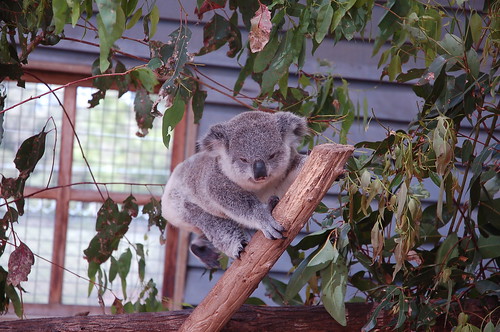
Koala in the Dream World, Gold Coast, Queensland


Koala is shy and slow. Look at this one. It is moving from one branch of tree to the other, slowly, and gracefully.
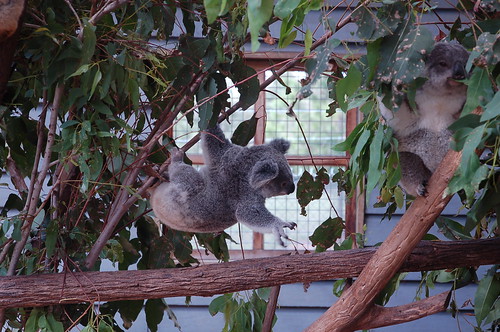
The other one.

I share at least one habit with Koala – sleeping. A Koala sleeps as much as 20 hours a day. This lazy little guy falled sleep again.
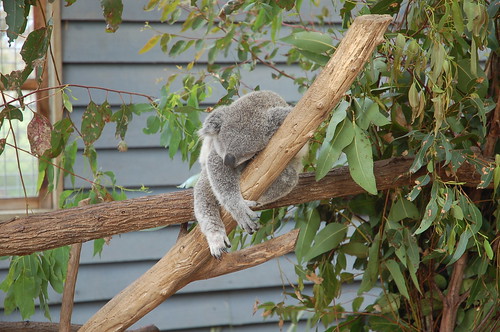
This sleeping Koala is in the Tangaro Zoo in Sydney
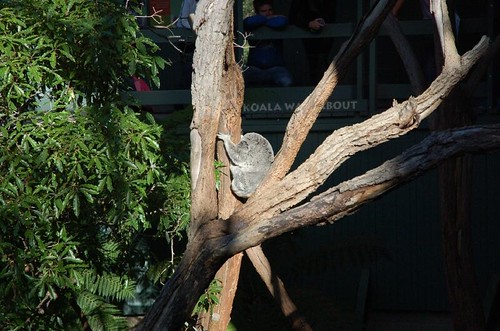
I start to wonder what the Koalas are thinking about everyday. They seem to be very happy everyday with a smooth tree branch to stay, nice sunshine to keep them warm, and delicious tree leafs to eat… Seems pretty good life, isn’t it?
Facade of Nice Buildings
During this trip, the facade of many nice buildings caught my attention. They are shining in the sky and is just as the graphs I draw in university.
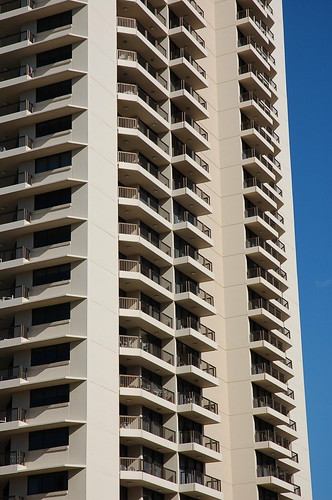
Service apartment in Surfers Paradise
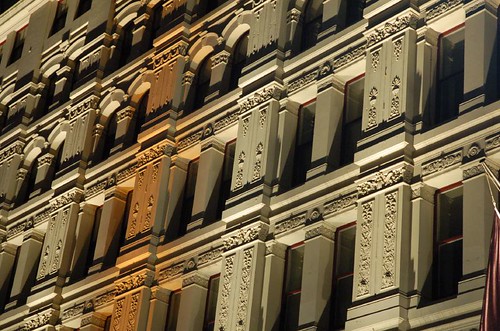
Building along the George Street in Sydney
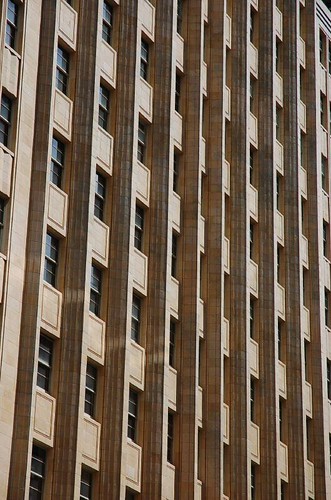
The tall building along the Martin Place in Sydney
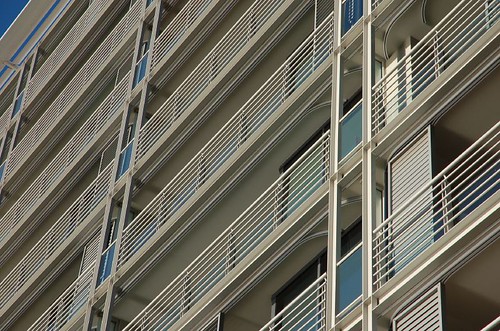
The building on the east side of the Circular Quay,Sydney
Beach of the Gold Coast
These days, I am working hard to post some pictures of the trip and share it with my family and friends. Here is another such post.
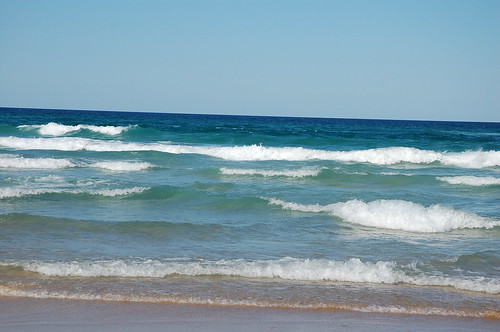
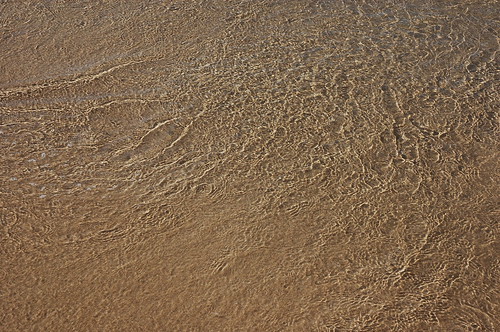
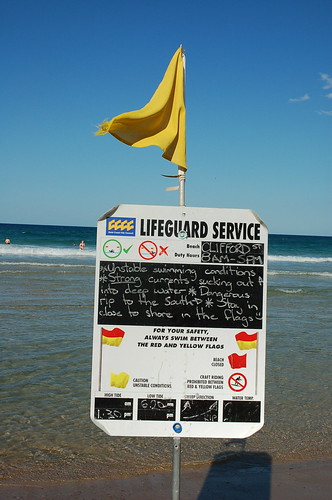
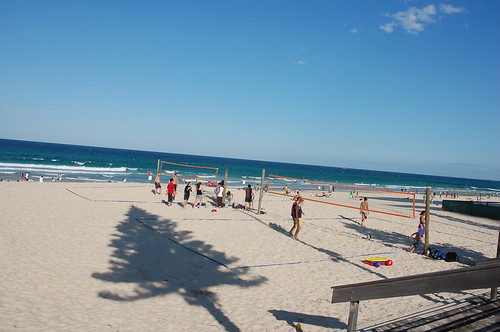
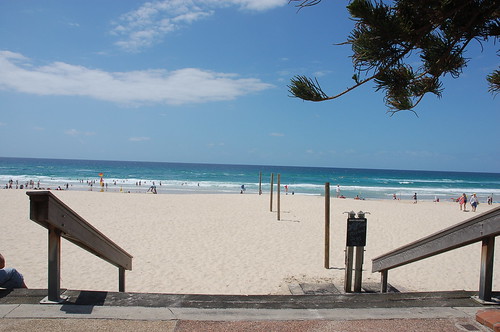
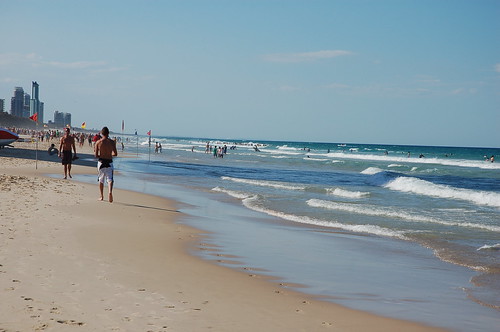
The tide of the Surfers Paradise, as the name implies, is very suitable for surfer, and not so good for swimmers.
I like the tide (only the tide, not water) in Qingdao better, since it was soft and gentle. In the Surfers Paradise, when the tide goes away, the water is just as high as your knees, but when the tide comes, it is higher than your head. The strong force of the tide sometimes create that kind of “water hole”, which the surfers love so much. For me, without a surfer board, it is just a water wall that I need to break into. The force strongly pushes me directly onto the beach. I have to get back to the original position.
In conclusion, very good for surfers with surfer board, and kind of depressing for swimmers – you just cannot swim in tide like that.
Fire in the Surfers Paradise
When we stepped into the Watermark Hotel in Surfers Paradise, I happen to witness a fire on the bridge over the river.
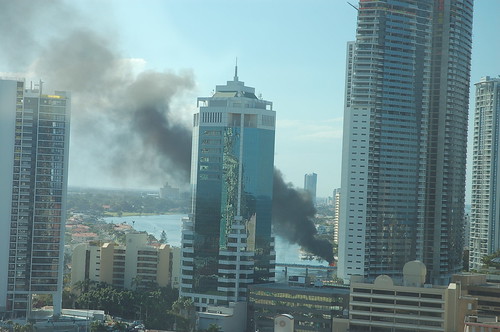
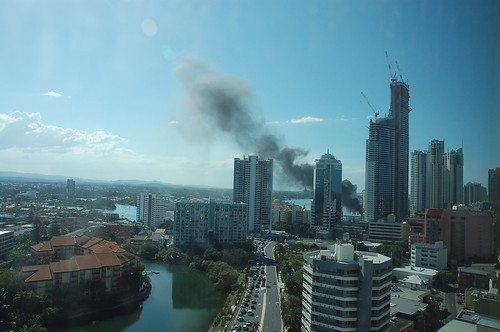
Fire fighter arrived and within 5 minute, the fire was put off.
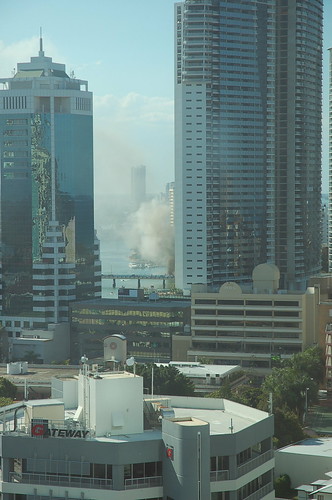
There was no news on TV or on Internet about the fire.
Seagull at Sea
Photograph by Jian Shuo Wang
Photograph by Jian Shuo Wang
Photograph by Jian Shuo Wang
Photograph by Jian Shuo Wang
Photograph by Jian Shuo Wang
Photograph by Jian Shuo Wang
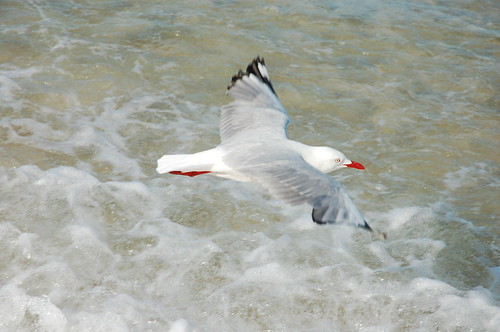
Photograph by Jian Shuo Wang

Photograph by Jian Shuo Wang
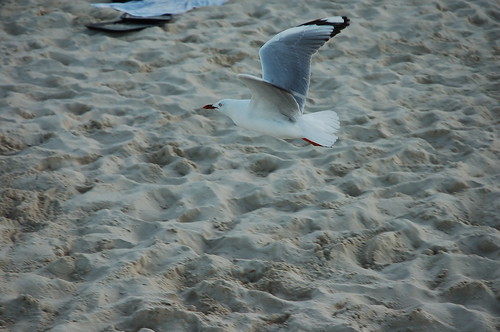
Photograph by Jian Shuo Wang
These pictures were taken at the Surfers Paradise, Gold Coast, QLD.
Look at how clean the water in the beach is! I cannot believe it is the water from the sea! It is as clear as the creeks in mountains. However, it is still bitter – as bitter as sea water.
